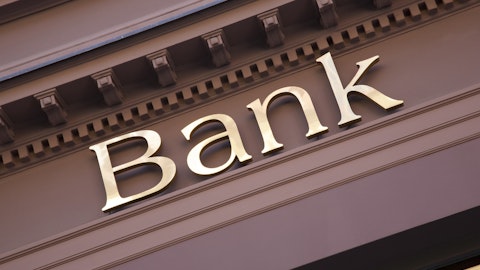Banco Santander, S.A. (NYSE:SAN) Q2 2023 Earnings Call Transcript July 26, 2023
Banco Santander, S.A. misses on earnings expectations. Reported EPS is $0.14 EPS, expectations were $0.17.
Begona Morenes: Good morning, everybody, and welcome to Banco Santander’s Conference Call to discuss our Financial Results for the First Half of 2023. Just as a reminder, both the results report and presentation we will be following today are available to you on our website. I am joined here today by our CEO, Mr. Hector Grisi; and our CFO, Mr. Jose Garcia-Cantera. Following their presentations, we will open the floor for any and all questions you may have in the Q&A session. [Operator Instructions] With this, I will hand over to Mr. Grisi. Hector, the floor is yours.
Hector Grisi: Thank you, Begona. Good morning everyone, and thank you for joining us. Let me just share with you what we will focus on today. First, I will talk about our half one results on the context of how we are progressing with the strategy we outlined at our Investor Day. Jose will then review our financial performance in greater detail. And then, I’ll conclude with a few closing remarks. Despite the challenges the financial system experienced at the beginning of the year, Q2 was another strong quarter for Santander demonstrating the strength and resilience of our strategy and unique business model even in times of market volatility. We delivered record profit of €2.7 billion, an increase of 14% compared with Q2 in ‘22, thus plus 17% in constant euros.
In the first half of ‘23, profit was €5.2 billion, up 7% supported by robust customer revenue growth. Revenue increased double-digits year-on-year, supported by all regions and global businesses. Global scale and network businesses are contributing around 40% of total Group revenue. Our number of customers grew by nine million year-on-year taking the total to 164 million and loans increased by 1% and deposits by 5%. The Group continues progressing towards a simpler and more integrated model through One Transformation. The program that is accelerating our structural model change to drive efficiency improvement, and growth in profitability. As a result, our efficiency ratio improved one point-three percentage points year-on-year to 44.2% and our net operating income grew double-digits.
Our return on tangible equity RoTE rose 80 basis points year-on-year to 14.5, while our earnings per shares improved 13% year-on-year supported by greater profit and share buybacks. At the same time, our strong balance sheet with solid and sound capital ratio, liquidity at comfortable levels and robust credit quality contributed to solid profitable growth, value creation, and shareholder remuneration. These results allow us to deliver value creation in terms of TNAVps plus EPS year-on-year of 11%, of which represents an increase of more than €6 billion in the first six months of the year. Moving on to the income statement. Firstly, remember that as we usually do, we are presenting growth rates, both in current euros and constant euros. This quarter, there was no material difference between them.
As I have just mentioned, profit increase in the first half, supported by, first of all, a strong line performance with all the regions and global businesses growing; cost in line with our expectations growing 1% point below the rate of inflation; double-digit growth in net operating income to approximately €16 billion, which demonstrates the strength of our results; and low loss provisions normalizing land with our expectations. These Trends resulted in our highest quarterly profit on record 4% higher than in Q1, even after the following impacts, net of taxes recorded in Q2. The SRF contribution of more than €200 million and additional Swiss mortgage provisions in Poland of €140 million and one-offs in Brazil of €137 million. Jose will go into more detail on all of these points later on.
This was a great first half, that makes us confident that we will deliver on our 2023 targets. Good business dynamics are translating into double-digit revenue, growth; our efficiency ratio improved as a result of good cost control and revenue trends; our cost of risk remains contained in line with our target of keeping it below 1.2% at year end. CET1 was 12.2 after profitably growing our businesses organically, and at a comfortable levels allowing us to accrue funds to meet our shareholders’ remuneration targets of a 50% payout. Our RoTE also grew year-on-year to 14.5 on track to reach our target at would already be close to 15% if we don’t analyze extraordinary banking tax on revenue earned in Spain. As we announced at our Investor Day we have entered into a new phase of value creation that will help us grow TNAVps per share plus EPS at a double-digit during the year – or through the cycle.
I like to spend a couple of minutes updating you on the progress of our transformation plan, now that we are six months down the road from our Investor Day. We are transforming the Bank in the right way because we’re structurally changing our model to improve both cost and revenue. We are making great progress in the implementation of One Transformation, creating a common operating model and technology for our retail business across our entire footprint. To better serve our customers and to improve efficiency and increase the size and profitability of our customer base we are delivering across the three, pillars of One Transformation. In simplification, we already have reduced 5% our number of products, nearly 400 fewer products in 2023. We are progressing in our digital self-service model, increasing the availability of products and services in our digital channels and reducing the use of our contact center by 17% just alone in the first quarter of ’23, compared with the same period last year.
We are digitalizing the onboarding process and to enter in Mexico. This initial pilot has resulted in a 36% growth in digital accounts per month, compared to those in 2022. And we have already captured around €70 million in savings so far in the U.S. from transformation and simplification initiatives. As you can see on this slide, the initial efficiencies for One Transformation, and the impact of our good sprint management in a context of higher rates, higher interest rates which our CFO will cover later in depth, have already contributed 85 basis points in efficiency improvements. Our Global and network business keep contributing to the Group’s profitability and have already delivered another 43 basis points. Multi Latinas and multi Europeans our initiatives to better serve our Multinational corporates and SMEs through regional coverage model are growing at a very high rates with revenue increasing by more than 70% year-to-date.
In asset management, we have progressed to enter the alternative business is starting to serve open market and institutional segment and has reached more than €2 billion commitments already. In payments, we have deployed that in Portugal and Argentina in the first half and we expect to launching latest in Chile, in the second half. In Auto, we’re increasing managing OEMs and retail relationships globally, expanding our partnerships in Europe to LATAM and the U.S. We have recently onboarded new partners in the US, leverage the existing agreements in Europe, which are expected to materialize in around €4 billion of new business per year. We have also deployed a new parent regional leasing platform in two markets and more countries will be added throughout ‘23 and ‘24.
Finally, our global technology capabilities have already resulted in 36 basis points improvement in the efficiency ratio. Our Global approach to technology has allowed us to capture €80 million in savings this year, mainly driven by One Transformation and efficiencies from the recent development and deployment of Gravity in two countries, which has contributed with €31 million in savings in the first half. A new global agreement with vendors, which represent around €40 million in cost reduction year-to-date. The actions that we are beginning to carry out as a part of One Transformation, which we are expanding across the Group are starting to be reflected on cost and on operational efficiencies. As you can see on this slide, simplification has already driven significant improvements in our cost and revenue per active customer ratios.
The solid progress we are making with the process digitalization and automation to capture efficiencies enables us to spend less time on operations in branches, and turn the branch, network into a powerful sales and advisory channel. Portugal has already taken out most of the operational activities from the branches freeing up branch employees, so that they can spend more time supporting customers and commercial activities. We’re extrapolating this to other of our banks. In only six months through One Transformation, we have already reduced the number of operational FTEs per million customers by 3%. We are already deploying global tech platforms to improve customer experience, leverage economies of scale, and extend best practices. Open Digital Services, as we call it ODS, our cutting-edge front-end platform allows to deliver a best-in-class omni-channel experience to our customers.
At the same time, that Gravity, our award-winning core banking platform drives significant efficiencies versus mainframe technology. We have integrated both in the U.S., so we will operate it on an end-to-end cloud-based retail technology stack core and omni-channel, which is already tested and will result in significant improvements in service quality and customer experience. Our global and network businesses continue to contribute to this new phase of value creation. In CIB we continue growing strongly after record performance in 2022, beating the market. Our global presence has allowed us to grow at 24% year-on-year, well above the average of annual growth target of 10% for the period ‘20 to ‘25. Because, first of all, we can provide a One-Stop shop service to our clients across all geographies, thereby capturing cross-border flows and because we bring CIB products and services to all wealth, retail and commercial clients across a group and vice-versa.
As a result, revenue related to these two concepts which we call network revenue grew 27% year-on-year to €2 billion. Wealth management and insurance grew 25% percent year-on-year, well above our target and this has been boosted by the finance benefits obtained from the Santander network effect. A fundamental part of our value proposition in private banking is how unique combination of local presence and local reach, a global reach. Our customers can move and transact easily from one country to another and that’s the reason why customers have €50 billion in assets under management book abroad, 10% higher than one year ago. Our payments business is also growing very strongly. Two years ago, we’ve began to move our payments business on to scale global platforms.
And, as of today, our payments platform already manages a significant part of all payments in the Eurozone and we are progressing in another key countries such as Brazil, Mexico, and the UK. We are in the process of expanding our cards platform across the Group, delivering real-time digital processing capabilities to our banks, accelerating our business growth, as well as generating operational synergies of around €100 million per year during the next two years alone. First delivery of the platform will be live in Brazil by the second half or 2023. In auto we continue to prioritize profitability, our market share growth in a context of rising interest rates. Our transformation plan, which is making us more – much more efficient and increasing contribution of our global and network businesses is helping us reach our 2025 profitability targets across all regions and businesses.
As I mentioned earlier, the Group’s RoTE rose 80 basis points year-on-year to 14.5% and would be around 15% if we didn’t analyze the extraordinary banking tax in Spain, which is in line with the Group’s targets for 2022 – sorry ‘23 and ‘25. Jose will now go in more detail through the Group’s first half performance. Please Jose.
Jose Garcia-Cantera : Thank you, Hector, and good morning, everyone. [Audio Gap] and Latin America driven by growth in volumes and fees. Digital Consumer Bank benefited from asset repricing actions and gains on financial transactions due to FX hedges. We also saw a strong performance across businesses. The only exception was auto, the result of lower leasing income in the US, which as in previous quarters, was affected by an increase in the share of end of leased vehicles, repurchase at the dealership. Revenue at the corporate center also improved up nearly €400 million due to higher liquidity buffer remuneration and a lower impact from FX hedging, which negatively affected revenue last year. Most of our revenue growth came from NII, which continued its upward trend increasing 6% in the quarter alone, driven in particular by Europe.
We see upside potential for further growth in the coming quarters. First half 2023 was 15% higher year-on-year in constant euros with positive sensitivity to raising rates mainly in Europe and Mexico and volume growth in auto, North America and South America, which more than offset negative in duration sensitivity in Brazil, Chile and auto. In terms of profitability, we have improved our margins every quarter since the first quarter of 2021. We continue to actively manage our credit spreads to make the most of the higher interest rate environment. Gains from credit yields outweighed higher funding costs. Thanks to our disciplined deposit remuneration strategy adapted to each country’s specific needs. In Europe, we are strictly managing deposit costs, especially in Spain and Portugal where there is excess liquidity in the system and much lower credit amount.
The UK has a more competitive environment in line with our expectations. In LATAM, deposit rates are more directly linked to market interest rates, which implies negative sensitivity and will benefit margins when rates start to decline over the next few months. Finally, in the U.S., deposit betas are higher due to the heightened competition following the collapse of Silicon Valley Bank. All-in-all, net interest income sensitivity to interest rates has resulted on €500 million above the assumptions that we shared during our Investor Day. Therefore, we are well on track to meet our double-digit NII growth guidance for 2023. Turning now to fees, in an environment of low fee growth in general as a result of subpar loan demand, weaker activity, consumer activity and higher margins, our net fee income grew at 4% in the quarter compared with the same quarter last year and 5% in the first half year-on-year.
CIB and PagoNxt are leading the way in terms of growth. CIB is increasing its share of leading roles and mandates and PagoNxt continued to expand total payment volumes, which rose 25% year-on-year and transactions 32%. We also had a very good performance for cards with turnover increasing 9% year-on-year with fees growing 20%. Retail banking also continued to grow well, primarily driven by an increase in customers and transactionality . Wealth management and insurance grew less as customers moved to lower risk, fixed income products with lower fees and margins. However, we saw volume improvements in both, private banking, net new money of €6.5 billion and Santander Asset Management over €3 billion net sales. Auto performance year-on-year was affected by the new insurance regulation in Germany in the first quarter but recovered significantly in the second quarter.
In terms, of course, our transformation efforts that Hector took you through earlier are paying off despite initial investments cost in real terms are growing below the rate of inflation across most of our footprint reflecting the savings we are beginning to generate on our strict control. This in turn is reflected in efficiency improvements led by Europe which improved seven percentage points, thanks to strong revenue gains together with a 2% fall in costs in real terms. As a result, Group efficiencies already at the bottom end of our target range where we expected to remain for the rest of the year. Credit quality remains robust, across our footprint. The non-performing loan ratio remains stable in the context of an expected soft lending and a strong labor markets as unemployment is a key driver of credit quality.
Of note, were the positive trends in Brazil driven by the more selective lending policies that we introduced a year and a half ago. We said in the fourth quarter of last year that we believe the Brazil NPL ratio had already peaked, and trends so far this year support that view having improved almost 60 basis points year-to-date. In terms of cost of risk, we remain comfortably on track to meet our 2023 target to remain below 1.2%. Spain continues to perform well, with a 12-month cost of risk, down 16 basis points year-on-year, supported by the quality of the long book and improving macro conditions. Normalization in the US continues, but is more resilient than anticipated. Brazil remains elevated due to the unsecured individual borrowers portfolio, but we are seeing signs that cost of risk has stabilized.
Brazil’s 12-month cost of risk at the end of June was 4.74%, but if we annualize the first six months, that improved to 4.5%. Mexico is increasing from low levels, mainly due to a changing mix towards unsecured loans which require more provisions upfront and obviously is more profitable. Other units, such as the UK, Portugal, and the digital consumer bank are rising, but from a very low base and should remain below all in line with through the cycle averages. Moving on to our balance sheet structure. As we have discussed in previous presentations, our credit portfolio is well diversified by segment, product, and country. Moreover, our balance sheet is low-risk. The portfolio is highly secured with quality collateral and has low average loan to values.
Loan growth year-on-year, was flat in constant Euros as growth in auto and consumer was offset by falls in CIB, mainly in Spain from very high levels in 2022, mortgages driven by early repayments in Europe and slowing demand from corporate, also in Europe. We saw positive dynamics in North America, South America, and DCB. On the other hand, deposits continue to grow well, up 4% year-on-year following a €3 billion increase in the second quarter in constant Euros, reflecting new customer capture with more than offset mortgage prepayments. We saw growth across the Bank concentrated mainly in time deposits as customers seek higher rates. Our deposit base is diversified and highly stable. Using LCR criteria 75% of our deposits are transactional, which are stickier and a high proportion of all deposits from individuals are covered by deposit guarantee schemes.
We have not seen any unusual movements in deposits in the year-to-date following market turmoil, particularly in the U.S. In fact, deposits in the U.S. grew in the quarter and remained flattish year-to-date which implies that we are gaining market share in deposits and with an average cost which was well below our main competitors. Mutual funds have begun to recover, up 4% year-on-year following a year of instability in 2022. To close, let me cover capital. Our fully low risk capital ratio remains at a comfortable level of 12.2% backed by strong organic capital generation, which was again 10 basis points, net of dividend accrual in the quarter. We accounted for the payout of the minority shareholders in Mexico, which costs four basis points in terms of capital.
We also had a series of other small positives and negatives this quarter that almost offset each other. We continue to focus on profitable growth opportunities, which is reflected in a front book RoRWA of 2.9% up from 2.5% in the first half of 2022, which is equivalent to a return on tangible equity in excess of 15% – sorry, in excess of the current Group return on tangible equity, which will support profitability going forward. Additionally, we continue to increase balance sheet mobilization and the percentage of risk-weighted assets with positive economic value added progressing well, towards our Investor Day target of 85 in 2025. This increased profitability will help us continue to build capital over the next few years and we are confident our capital ratio will remain above 12% even after taking into account, the final implementation of BASEL III on January 1st 2025.
Let me turn it back to Hector for his concluding remarks. Thank you.
Hector Grisi : Thank you, Jose. In summary, Q2 of ‘23 was another strong quarter supported by customer growth, double-digit revenue increase, and also backed by strong performance by all the regions and businesses. We are accelerating the structural change to a simpler and more integrated model through One Transformation spreading the initiative all across the Group, which is driving efficiency improvement, and also profitable growth. A rock solid balance sheet and robust credit quality are contributing to growth, calue creation and shareholder remuneration. In summary, we have a very strong first half of the year and we are confident that we will achieve our 2023 targets and remunerate our shareholders in line with our 50% payout policy supported by our global and network businesses while we continue with our structural model transformation.
We see upside potential for further net interest income growth in the coming quarters, as tailwinds in Europe and Mexico, are expected to remain and inflation and interest rates in our largest Latin American – Latin American countries seem to have picked or nearly picked resulting in a positive outlook for margins in the next 6 to 9 months. Cost of risk is normalizing in line with our expectation. In a context of an expected soft landing of the economy and a strong labor markets, we continue to see resilient customer and corporate behavior in most of the geographies. Group RoTE has reached 14.5% in the first half and we expect to close above 15% at the end of the year. All in all, our TNAV plus cash dividend is growing at a double-digit, well on track with our target of average growth through the cycle.
And now, we will be happy to take any of your questions. Thank you.
See also 26 Biggest Marijuana Companies in the World and 20 Most Visited Countries in Asia.
Q&A Session
Follow Banco Santander Chile New (NYSE:SAN)
Follow Banco Santander Chile New (NYSE:SAN)
Operator: [Operator Instructions] We already have the first question from Carlos Peixoto from CaixaBank BPI. Please go ahead.
Carlos Peixoto : Hi, good morning. Thank you for taking my call – my question. The first question would actually be on Brazil. Margin stabilized quarter-on-quarter, it’s still a bit under pressure year-on-year. I was wondering what evolution you expect for the rest of the year? And also on cost of risk what’s the Outlook there? Then the second question would actually be on capital. So basically the capital generation in this quarter was only three basis points a bit below the runrate you have discussed in previous quarters. I reckon that this partially has to do with the Mexico minorities incorporation, but I was wondering how do you see this evolving throughout the rest of the year? And also, what is behind the increase in RWAs in this quarter? Thank you very much.
Hector Grisi : Thank you, Carlpos. What I’ll do is, I’ll – last – the first question on. Brazil we will give you a comment on capital and then Jose will tell you a little bit about what’s going on with increasing RWA, okay? In terms of the Brazil margin quarter-on-quarter, as we say, basically is explained by the following: our launch since 2021, we have become much more conservative and growth – grown volumes very selectively changing the loan mix to lower risk. Okay? So we mainly get out – we’re out of credit cards. Went on to Consignado, auto loans and mortgages. On deposits also the fast increase in rates has meant a rapid rise in the cost of deposits, okay, as well as a change of the mix on the deposits. Rates are staying higher for longer has prevented the cost of deposit from coming down impacting NII.
Remember that in Brazil, we have negative sensitivity to rates, okay? So Brazilian NIIs in the second quarter of ‘23 is already flat. Okay? As we set and Jose was very precise on that the worst since behind us and we are already seeing a reduction on the average cost of deposits and we also see an improved customer spread. Okay? So we expect NII in the second half of ‘23 to be higher than the first half of the year leading to a flat NII in the year with a substantial improvement in ‘24, okay? In terms of the cost of risk, not only the macro outlook is improving, but since ‘21, I just – I explained, we’ve been very selective in the approach of the new lending extension and focusing to more secure and higher rate customers as I explained, okay?
This is showing good results and we believe the worst, as I said, it repeatedly is worst – sorry the worst is behind now. Cost of risk in the second quarter is already improving, versus the first quarter and the vintages are showing really good performance as we have seen. So we don’t expect cost of risk that will deteriorate in Brazil in ‘23 versus ‘22, excluding the one-off that which implies staying close to around 4.6%, okay? And then, to be on capital to be very precise, we expect to generate at least 10 basis points of organical capital on average per quarter with the current shareholder remuneration policy that we put in place. As a result, we will be on track to meet our target to be above 12% even when the final implementation of BASEL III comes into effect on January 1st on ‘25, okay?
And with that, I don’t know, Jose, you can comment on RWAs please.






